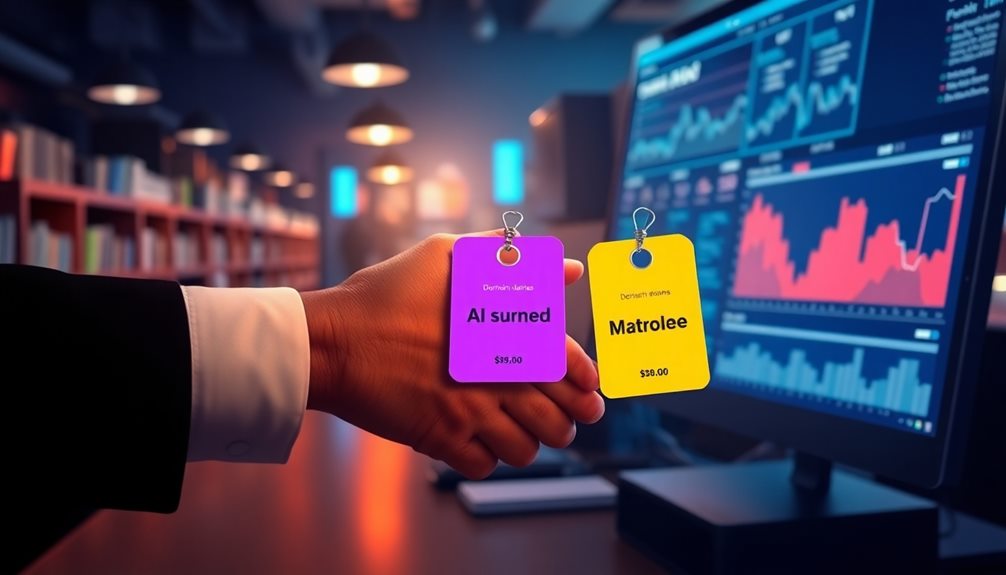Unseen AI systems now influence over a billion consumer interactions worldwide, transforming how markets operate and economies grow. These advanced tools personalize experiences, provide deep insights, and enable new business models across sectors like retail and finance. Regional adoption varies, but the overall trend is toward greater integration of AI-driven systems in daily consumer activities. If you want to understand how these invisible forces shape the economy behind the scenes, there’s more to uncover ahead.
Key Takeaways
- AI systems are driving global economic growth by enhancing productivity, creating new business models, and increasing consumer engagement across regions.
- Regional disparities in AI adoption reflect infrastructure, investment, and economic maturity, influencing consumer market dynamics worldwide.
- Consumer behavior shifts as AI personalizes experiences and products, with billions using AI tools daily, shaping demand and market opportunities.
- Mapping AI technologies across industries reveals evolving roles, task automation, and the transformation of how products are created, marketed, and consumed.
- Unseen AI systems underpin the global consumer economy, facilitating data-driven insights and fostering innovation beyond conventional awareness.

Unseen AI systems are quietly transforming the global consumer economy, driving unprecedented growth and innovation across industries. You might not notice these changes directly, but they considerably influence how products are created, marketed, and consumed. AI is projected to boost the world’s GDP by up to 14%, adding around $15.7 trillion by 2030. Over $9 trillion of that comes from increased consumption of AI-enhanced products and services, driven by personalized offerings and smarter use of your time. Generative AI alone could contribute between $2.6 and $4.4 trillion annually and improve labor productivity growth by up to 0.6% each year through 2040. This creates a virtuous cycle: as more data points are generated, AI systems gain better insights, leading to innovative products that attract more consumers and further data collection. When combined with IoT connectivity, AI-driven disruption sparks new business models across sectors, fueling ongoing innovation. Global AI adoption rates are accelerating rapidly, further amplifying these effects across the economy.
You’ll see how AI adoption varies geographically, with high-income countries like the US and Singapore leading the charge. Emerging markets grow at faster rates, benefiting from rapid productivity gains and workforce transformation. In mature markets, AI shifts from automating simple tasks to more complex and collaborative business operations. The US accounts for 21.6% of total AI usage, but adoption intensity varies by region—places like Washington D.C. and Utah outpace states like California in per capita use. These patterns reveal ongoing economic convergence and divergence, reflecting different stages of structural transformation across regions. Regional disparities in AI adoption highlight the importance of infrastructure and investment in shaping economic outcomes.
AI’s influence on consumer behavior is profound. It helps businesses gather detailed customer insights, enabling highly personalized products that meet your preferences more precisely. Today, approximately 1.7 to 1.8 billion people worldwide have used AI tools, with half a billion engaging daily—showing mass adoption and habit formation. Despite widespread use, monetization remains limited, with only about 3-5% of users paying for premium AI services, leaving significant growth opportunities. AI personalization shifts demand and creates new market dynamics, giving front-runners a competitive edge. By mapping over 185 AI technologies across retail and financial sectors, analysts track how AI impacts the economy, revealing evolving patterns, task types, and regional adoption stages. This data helps you understand how AI is transforming industries, workforce roles, and consumer habits on a global scale.
Frequently Asked Questions
How Do These AI Systems Impact Consumer Privacy Globally?
AI systems impact your privacy globally by collecting vast amounts of personal data without clear transparency or control. They analyze your habits, location, and even sensitive attributes, often risking data breaches or misuse. These systems can deanonymize data, enabling targeted scams or discrimination. As a consumer, you face growing surveillance, reduced privacy, and potential economic harms, making it harder to trust how your personal information is used or protected worldwide.
What Countries Are Leading in AI Consumer Economy Mapping?
You should know that the United States leads in AI consumer economy mapping, accounting for 21.6% of conversations and boasting a nearly $74 billion market in 2025. Singapore also stands out for its intense AI adoption, despite its small size. Other regions show less activity, highlighting how AI growth is concentrated in high-income countries like the U.S. and parts of Asia, where infrastructure and investment fuel rapid adoption and diverse use cases.
Are There Ethical Concerns With AI Tracking Consumer Behavior?
Yes, there are ethical concerns with AI tracking consumer behavior. You need to contemplate privacy issues, ensuring you get clear consent and transparently communicate data collection methods. Be mindful of algorithmic bias that can lead to discrimination, and avoid manipulative practices. You should also respect user autonomy by offering control over their data, continuously monitor for bias, and stay compliant with regulations to build trust and uphold ethical standards.
How Accurate Are These AI Systems in Predicting Market Trends?
While AI systems excel at analyzing vast data to predict market trends, their accuracy isn’t foolproof. You might see high statistical reliability, but external shocks like geopolitical events or unforeseen crises can throw predictions off. AI’s strength lies in refining forecasts over time, yet it struggles with rare, unpredictable events. So, you should view these predictions as valuable guides, not infallible certainties, especially in volatile markets.
What Industries Benefit Most From AI Consumer Analysis?
You’ll find that consumer goods, retail, and marketing benefit most from AI consumer analysis. These industries use AI to personalize experiences, analyze customer feedback, and tailor marketing strategies, boosting revenue and loyalty. AI helps them understand trends, preferences, and behaviors in real-time, enabling more targeted campaigns and product offerings. As a result, they see increased sales, improved customer satisfaction, and deeper engagement, making AI essential for staying competitive in these sectors.
Conclusion
As you consider these unseen AI systems, imagine them as invisible threads weaving through every purchase and click, silently shaping your consumer world. They’re like digital cartographers mapping your habits, guiding companies behind the scenes. While you may not see them, they’re the unseen architects of the global economy, constantly adapting and evolving. Recognize their presence, for they hold the power to redefine how you buy, sell, and connect in this digital age.










